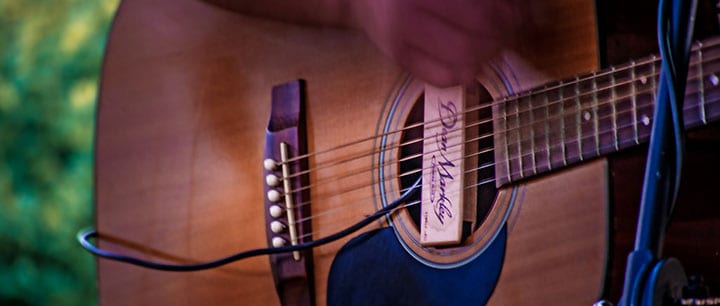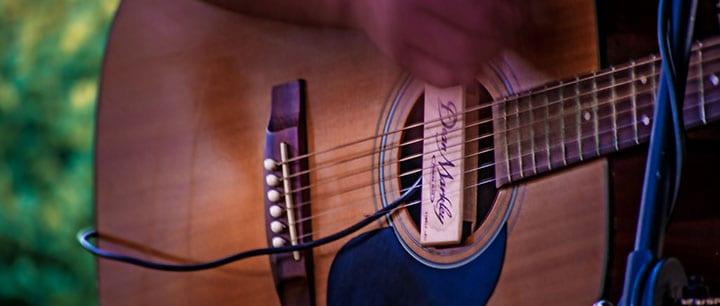 Are you ready to buy a guitar? Before you part with your hard-earned cash, find out how some minor adjustments can make a world of difference in this guest post by Perth Amboy, NJ guitar teacher Jeff S...
Are you ready to buy a guitar? Before you part with your hard-earned cash, find out how some minor adjustments can make a world of difference in this guest post by Perth Amboy, NJ guitar teacher Jeff S...
There’s nothing like the thrill of picking out or buying a new guitar. But did you know that very few new guitars are set up for optimum playability? Well, it’s true. It’s a rare guitar indeed that plays with maximum ease, right off the rack at the music store.
However, if you get smitten with the looks of an instrument, only to get it home and find it a bear to play, don’t panic. There’s a very good chance it can be adjusted and transformed into an easy-to-play, pain-free instrument.
You Bought A New Guitar, Now Make Sure It Has New Strings!
If you’re buying a new guitar off the rack, keep in mind that many sets of hands played it before you. Because of this, the strings can often sound dull and be tough to glide across. So unless the instrument you end up buying was recently put on the rack or brought in from the storeroom right out of the box, you may encounter dead strings. You can ask the salesperson or store owner to put on new ones, which they may include or may charge you for–but either way you want new strings!
But You May Need More Than Just New Strings…
While putting on a set of brand new strings will produce a significantly brighter, more ear-pleasing sound, they will not make the notes any easier to fret, nor will they reduce finger discomfort. If you’re experiencing discomfort virtually every time you play, you most likely need an “action” adjustment.
What’s an Action Adjustment?
Lowering the action brings the strings closer to the fretboard, and that in and of itself should relieve a lot of your weary, notched-up fingers. This action adjustment is done by using an Allen wrench, which comes with your guitar (don’t lose it!), by inserting it into a little slot inside the sound hole of the guitar. This controls the position of the truss rod, the steel rod which spans the neck of the guitar. If this all sounds too technical, don’t worry–all you need to do for your hurting fingers is take your guitar in to a repair shop (or the store you bought it) and ask them to please lower the action as much as possible without the strings buzzing too much. Simple as that!
How Much Does a Truss Rod Adjustment Cost?
Depending on the store, your relationship with them, their mood, how busy their store is (or more specifically, how busy their repair person is the day you’re there), and what you spent on the guitar, they may or may not charge you anything to do a truss rod adjustment. If they do, it shouldn’t be more than $20.
Couldn’t I Save the Money and Time and Do This Adjustment Myself?
I’d suggest having a professional guitar tech or repair person do the action adjustment the first couple of times. The reason I say this is because you don’t want to turn a not-so-great-playing guitar into possibly an unplayable guitar. Or worse yet, you don’t want to harm the instrument and throw the neck out of whack or put too much pressure on your bridge. Until you get a feel for what needs to be done to adjust the neck, it’s best to watch a pro do it. Ask questions and take notes, so you can eventually do your own adjustments.
What if the Adjustment Doesn’t Make My Guitar Easier to Play?
Quite often a truss rod adjustment is enough to get the action significantly lower to the point where it’s a lot easier to play. But in those cases where it doesn’t sufficiently improve things, a guitar “setup” is required. A guitar setup is a series of adjustments a guitar technician makes to lower the action so that a guitar plays as easily as possible (as well as intonating the guitar). It’s a much more involved and time-consuming job than a truss rod adjustment and often requires leaving the guitar at the shop. It might take a week or so to get the guitar back and it generally costs between $50 and $80 for a set-up. But if it’s done right, it’s well worth the money. Without it, the results can be sore fingers, frustration, and in extreme cases, blisters.
Best of luck with your new guitar, finding your ideal guitar setup, and your quest to have it play as easily and comfortably as possible.
 Jeff S. teaches guitar, ukulele, speaking voice, songwriting and more in Perth Amboy, NJ, as well as online. Jeff has created and taught songwriting and music business classes at colleges, universities, and music schools throughout the country for many years. Learn more about Jeff here!
Jeff S. teaches guitar, ukulele, speaking voice, songwriting and more in Perth Amboy, NJ, as well as online. Jeff has created and taught songwriting and music business classes at colleges, universities, and music schools throughout the country for many years. Learn more about Jeff here!
Photo by lavenderstreak
Suzy S.

